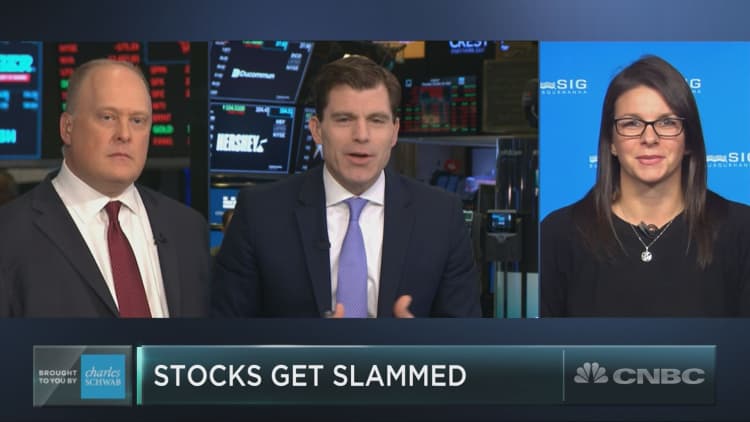
Stocks fell sharply on Thursday, adding to already steep losses for the month of October.
The Dow Jones Industrial Average dropped 327.23 points to 25,379.45, led by declines in Caterpillar. The fell 1.4 percent to 2,768.78 as the consumer discretionary and tech sectors lagged. The Nasdaq Composite pulled back 2.1 percent to close at 7,485.14. Overseas, China's Shanghai Composite dropped sharply.
Thursday's declines added to the market's steep losses for the month. The Dow and S&P 500 have fallen more than 4 percent each, while the Nasdaq is down nearly 7 percent in October. Tech, the largest S&P 500 sector by market cap, is among the laggards this month, dropping 7.1 percent.
Among the reasons for selling on Thursday, according to investors, were worries about the U.S.-China trade war, rising interest rates and lingering worries about possible overvalued U.S. tech stocks. Stocks also fell as Treasury Secretary Steven Mnuchin pulled out of a Saudi Arabia investment conference as traders worried a large global investor in the kingdom is coming under greater scrutiny.
Several stocks seen as economic bellwethers fell sharply in the U.S., including United Rentals and Textron, which dropped at least 11 percent each. Snap-on and Caterpillar, meanwhile, fell 9.6 percent and 3.9 percent, respectively. Large-cap tech shares like Facebook and Amazon both fell more than 2.5 percent, along with Alphabet and Netflix.
The Shanghai Composite dropped 2.9 percent and hit its lowest level since November 2014.
"Mr. Market is speaking loud and clear on China. The country is losing and needs to cry uncle," Nick Raich, CEO of The Earnings Scout, said in a note to clients.
"Chinese stocks are now at a four year low as rising U.S. interest rates and the likelihood of less favorable trade deals is going to adversely impact Chinese companies profits next year and its market price is re-setting lower to reflect that," Raich said.
This drop in Chinese stocks increased fears that China's economy, the world''s second largest, could be slowing down, dragging down global growth. These worries increased Thursday after European Central Bank President Mario Draghi said one of the risks for the economy was countries trying to circumvent EU budget rules.
Draghi's comments sent Italian bond yields to their highs of the day and sent major European stock-market indexes to their session lows.
Concerns over global trade were also sparked as National Economic Council Director Larry Kudlow went after China. "They are unfair traders. They are illegal traders. They have stolen our intellectual property," Kudlow said at the Detroit Economic Club on Thursday. "China has not responded positively to any of our asks."
Kudlow's comments come as the U.S. and China engage in protectionist trade policies, slapping tariffs on billions of dollars worth of each other's goods.
"Ultimately, they will come to the negotiating table," said Brent Schutte, chief investment strategist for Northwestern Mutual Wealth Management. "I don't see how it benefits either country to spark a recession."
U.S. equities were already under pressure as Treasury yields traded back around multiyear highs on Thursday. The short-term two-year yield hit its highest level since June 2008 before slipping. The benchmark 10-year note yield climbed to 3.205 percent.
Housing stocks also fell. The iShares U.S. Home Construction ETF (ITB) dropped 2 percent. They also fell after Bank of America Merrill Lynch downgraded shares of Toll Brothers, PulteGroup and NVR and reduced its forecast for housing starts.
The rise in bond yields came a day after the Federal Reserve released the minutes from its September meeting. The minutes showed the central bank is still convinced tighter monetary policy is the best course of action for the economy to remain steady.

"To me, this reflects a lack of trust in the Federal Reserve," said Craig Callahan, president at Icon Funds. "The market fears the Fed will over-tighten."
Yields have risen sharply recently. Last week, the 10-year yield — which is used as a benchmark for mortgage rates — climbed to its highest level since 2011. This rise has stoked fears that higher borrowing costs could slow down the global economy. These factors contributed to a sharp sell-off in equities last week.
"The bottom line is that the long end of the U.S. yield curve has managed to break out for the first time in several years and that other developed market yields have also been moving higher," said Michael Shaoul, chairman and CEO of Marketfield Asset Management. "The fact that U.S. yields only dropped slightly during last week's equity rout is a sign that little demand for these instruments was sitting on the sidelines and there are already signs that the long bond is ready to revisit its recent high at 3.44 percent."
The stronger yields offset robust corporate earnings results released Thursday. Dow-member Travelers, Bank of New York Mellon, BB&T and Danaher were among the companies that reported better-than-expected earnings before the bell.
Investors came into the earnings season with high hopes. Analysts polled by FactSet expected third-quarter earnings to have grown by 19 percent on a year-over-year basis. So far, the season is off to a good start. Of the S&P 500 companies that have reported, 84.1 percent have posted better-than-expected profits.
—CNBC's Spriha Srivastava contributed to this report.






